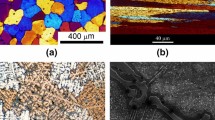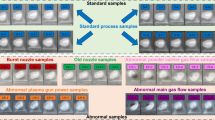Abstract
Surface quality analysis of polished surface has been the subject of many classic studies in surface polishing technology and is a key indicator for evaluating the polishing path. However, as an important part of surface quality, surface texture features have been ignored in many related researches. In this paper, a new method to analyze the texture features of polishing based on co-occurrence matrix is proposed. It provides a new perspective of surface quality analysis focusing on surface texture features. It extends the previous approach termed the residual level co-occurrence matrix (RLCM) focusing on the distribution of surface polishing residues, leading to more targeted and stabilized evaluation results. This method can be used in the path planning stage to estimate the polishing quality of the planned path without physical processing, which can avoid resource waste in the physical world. Furthermore, in this method, the usage of images is avoided, which can ensure that the results are not affected by the light and image quality. Simulation experiments as well as empirical investigations were conducted to verify the feasibility of the method. The results of both consistently reveal that the proposed method is able to accurately describe the texture feature and correctly analyze the texture feature.



















Similar content being viewed by others
Data availability
All data generated or analyzed during this study are included in this published article.
References
Sun Y, Jia J, Xu J, Chen M, Niu J (2022) Path, feedrate and trajectory planning for free-form surface machining: a state-of-the-art review. Chin J Aeronaut 35(8):12–29
Grzesik W, Rech J, Żak K (2015) Characterization of surface textures generated on hardened steel parts in high-precision machining operations. Int J Adv Manuf Technol 78:2049–2056
Xu J, Xu L, Geng Z, Sun Y, Tang K (2020) 3D surface topography simulation and experiments for ball-end CNC milling considering dynamic feedrate. CIRP J Manuf Sci Technol 31:210–223
Wang Z, Lin X, Shi Y, Zhang Y, Chen Z (2020) Reducing roughness of freeform surface through tool orientation optimization in multi-axis polishing of blisk. Int J Adv Manuf Technol 108:917–929
Liu W, Tu X, Jia Z, Wang W, Ma X, Bi X (2013) An improved surface roughness measurement method for micro-heterogeneous texture in deep hole based on gray-level co-occurrence matrix and support vector machine. Int J Adv Manuf Technol 69:583–593
Grigoriev AY, Myshkin NK (2015) Comparing Surface Roughness and Texture Concepts. In: Proceedings of BALTTRIB’ 6(1):6–69
Menezes PL, Kishore KSV, Lovell MR (2011) Role of surface texture, roughness, and hardness on friction during unidirectional sliding. Tribol Lett 41:1–15
Zhang KS, Liu K, Gao TY, Qiao YL, Zhang Y, Liu XJ, Wang W, Ye JX (2021) The unrecognized importance of roughness directionality to polymer wear. Wear 486–487(6):204084
Hamdavi S, Ya HH, Rao TVVLN (2016) Effect of surface texturing on hydrodynamic performance of journal bearings. J Eng Appl Sci 11:172–176
Yayoglu YE, Toomey RG, Crane NB, Gallant ND (2022) Laser machined micropatterns as corrosion protection of both hydrophobic and hydrophilic magnesium. J Mech Behav Biomed Mater 125:104920
Hladnik A, Lazar M (2011) Paper and board surface roughness characterization using laser profilometry and gray level cooccurrence matrix. Nord Pulp Pap Res J 26:99–105
Zhang J, Tan T (2002) Brief review of invariant texture analysis methods. Pattern Recogn 35:735–747
Peckinpaugh SH (1991) An improved method for computing gray-level cooccurrence matrix based texture measures. CVGIP Graph Mod Image Process 53:574–580
Soh LK, Tsatsoulis C (1999) Texture analysis of sar sea ice imagery using gray level co-occurrence matrices. IEEE Trans Geosci Remote Sens 37:780–795
Chopra S, Marfurt KJ (2007) Volumetric curvature attributes adding value to 3D seismic data interpretation. Society of Exploration Geophysicists - 77th SEG International Exposition and Annual Meeting. SEG 28:851–855
Dutta S, Pal SK, Mukhopadhyay S, Sen R (2013) Application of digital image processing in tool condition monitoring: a review. CIRP J Manuf Sci Technol 6:212–232
Gadelmawla ES (2004) A vision system for surface roughness characterization using the gray level co-occurrence matrix. NDT E Int 37:577–588
Huaian YI, Jian LIU, Enhui LU, Peng AO (2016) Measuring grinding surface roughness based on the sharpness evaluation of colour images. Meas Sci Technol 27:25404
Sun H, Gao D, Zhao Z, Tang X (2017) An approach to in-process surface texture condition monitoring. Robot Comput Integr Manuf 48:254–262
Haralick RM, Shanmugam K, Dinstein I (1973) Textural features for image classification. IEEE Trans Syst Man Cybern SMC-3:610–621
Bo H, Ao L (2006) Research on computation of GLCM of image texture. Acta Electron Sin 31:155–158+134
Srivastava D, Rajitha B, Agarwal S, Singh S (2020) Pattern-based image retrieval using GLCM. Neural Comput Appl 32:10819–10832
Chen ML, Dai SK (2012) Analysis on image texture based on gray-level co-occurrence matrix. Comp Technol 45(2):108–111
Conners RW, Harlow CA (1980) A theoretical comparison of texture algorithms. IEEE Trans Pattern Anal Mach Intell PAMI-2:204–222
Xu JT, Xu LK, Li YF, Sun YW (2020) Shape-adaptive CNC milling for complex contours on deformed thin-walled revolution surface parts. J Manuf Process 59:760–771
Sawhney R, Crane K (2017) Boundary first flatening. ACM Trans Graph 37(1):5:1–5:14
Neyrinck A, Verl A (2012) Optimale Maschinen und Anlagen durch Simulation von Varianten in der Konzeptionsphase. Automation 2012
Funding
This study was supported in part by grants from the National Defense Basic Scientific Research Program of China (grant no. JCKY2020210C002) and the National Natural Science Foundation of China—Liaoning Provincial Joint Fund (grant no. U1908230).
Author information
Authors and Affiliations
Contributions
JiaXuan Li performed the algorithm design and code writing and was a major contributor in writing the manuscript. The above work was completed under the guidance of Bo Zhou and Lun Li. Guang Zhu and Cai Ming analyzed and interpreted the experimental data. All authors read and approved the final manuscript.
Corresponding author
Ethics declarations
Ethical approval
Not applicable.
Consent to participate
Not applicable.
Consent for publication
Not applicable.
Competing interests
The authors declare no competing interests.
Additional information
Publisher's note
Springer Nature remains neutral with regard to jurisdictional claims in published maps and institutional affiliations.
Rights and permissions
Springer Nature or its licensor (e.g. a society or other partner) holds exclusive rights to this article under a publishing agreement with the author(s) or other rightsholder(s); author self-archiving of the accepted manuscript version of this article is solely governed by the terms of such publishing agreement and applicable law.
About this article
Cite this article
Li, J.X., Zhou, B., Li, L. et al. A method for analyzing the texture features of free-form surface polishing paths based on co-occurrence matrix. Int J Adv Manuf Technol 124, 601–618 (2023). https://doi.org/10.1007/s00170-022-10401-1
Received:
Accepted:
Published:
Issue Date:
DOI: https://doi.org/10.1007/s00170-022-10401-1




